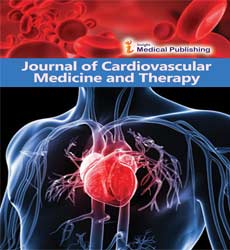Epidemiology of Heart Failure
Neha Grace
Department of Medicine and Therapy, Graz University of Technology, Austria
- *Corresponding Author:
- Neha Grace
Department of Medicine and Therapy, Graz University of Technology, Austria
Tel: 9063215428
E-mail: nehagrace1010@gmail.com
Received Date: December 03,2021; Accepted Date: December 16,2021; Published Date: December 23,2021
Citation: Grace N (2021) Circulatory Assist Devices in Cardiology. J Cardiovasc Med The Vol:4 No:3
Perspective
Hydroxychloroquine and azithromycin have been highlighted as potential coronavirus illness prophylactic or treatment options in 2019 (COVID-19). At crediblemeds. org, both medicines are recognised as definite causes of torsade de pointes. When used to treat systemic lupus erythematosus, hydroxychloroquine has been shown to lengthen the QT interval and cause torsade de pointes in rare cases. Antimalarial prophylactic drugs, such as hydroxychloroquine are thought to affect the entry and post-entry stages of SARS-CoV and SARS-CoV-2 infection, most likely through effects on endosomal pH and the resulting underglycosylation of angiotensin-converting enzyme 2 receptors, which are required for viral entry.
The antibiotic azithromycin is becoming better recognised as a rare cause of QT interval prolongation, severe arrhythmias and an elevated risk of sudden death; advanced age and female sex have been linked as risk factors. Azithromycin can cause non-pause-dependent polymorphic ventricular tachycardia as well. The observations that azithromycin medication makes the patient sensitive to corrected QT (QTc) interval lengthening and torsade de pointes were supported by the US Food and Drug Administration. Bioresorbable scaffolds are a significant step forward in coronary stent development, having the potential to significantly enhance the care of patients with coronary artery disease. On the 14th of April 2016, experienced professionals involved in the first-in-man studies convened in Zurich in an attempt to make first recommendations for the technology in order to gain consensus on a prudent commercial introduction. This paper will be updated when new clinical trial data becomes available, and it should be viewed as a review of existing data, opportunities, expectations, guidance and recommendations for future research.
Not just among top athletes, but also among amateur and recreational athletes, doping substances and methods are widely used. Athletes utilise a variety of medicines to improve performance, relieve anxiety, gain muscle mass, lose weight or disguise the use of other drugs during testing. Abuse of doping drugs and methods on the other hand, has been linked to a variety of health problems. Because there is a substantial inter-individual diversity in drug responses, the adverse effects are dependent on the type of medication eaten as well as the amount and duration of intake, and the body's sensitivity. The doses used in sports are typically significantly larger than those used in therapeutic settings, and the use of many medicines in combination is common, resulting in a higher risk of side effects. The cardiovascular side effects of doping are the most serious of the biological side effects. Drug misuse has been linked to myocardial infarction, hyperlipidemia, hypertension, thrombosis, arrythmogenesis, heart failure and sudden cardiac death. This paper analyses the research on the negative cardiovascular effects of illegal substances and procedures in athletes, with the goal of informing physicians, trainers and players as well as discouraging drug use during sports. Anabolic steroids, hormones and related compounds, beta-2 agonists, anti-estrogenic agents, diuretics and other masking agents are all strictly prohibited.
References
- Roden DM (2020) Considerations for Drug Interactions on QTc Interval in Exploratory COVID-19 Treatment. JACC 75:2623–2624
- Heidbüchel H (2006) ESC Study Group of Sports Cardiology Position Paper on adverse cardiovascular effects of doping in athletes. Eur J Prev Cardiol 13:687–694
Open Access Journals
- Aquaculture & Veterinary Science
- Chemistry & Chemical Sciences
- Clinical Sciences
- Engineering
- General Science
- Genetics & Molecular Biology
- Health Care & Nursing
- Immunology & Microbiology
- Materials Science
- Mathematics & Physics
- Medical Sciences
- Neurology & Psychiatry
- Oncology & Cancer Science
- Pharmaceutical Sciences
